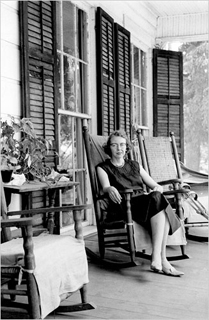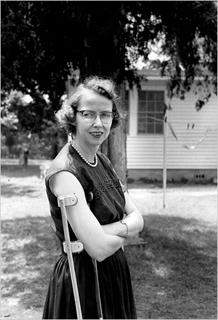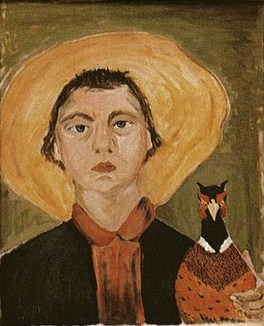"Staggering Between Despair and Presumption"
Flannery O'Connor's "Christian Realism"
For Sunday July 13, 2014
Lectionary Readings (Revised Common Lectionary, Year A)
Genesis 25:19–34 or Isaiah 55:10–13
Psalm 119:105–112 or Psalm 65:1–13
Romans 8:1–11
Matthew 13:1–9, 18–23
When Flannery O'Connor (1925–1964) died from lupus at the age of thirty-nine, she had published a modest amount of work — two novels, thirty-one short stories, and some essays and reviews. It was enough to make her one of America's greatest fiction writers. Joy Williams recalls how "Rust Hills, the fiction editor of Esquire, put her in the middle of the 'red-hot center' in his Literary Establishment chart of 1963."
O'Connor was an odd duck. She was an only child, socially awkward, deeply introverted, and colorfully eccentric. She described herself as a "pigeon-toed child with a receding chin and a you-leave-me-alone-or-I'll-bite-you complex." She laced her coffee with coke, told racist jokes, refused a visit by James Baldwin, never married, and collected exotic birds. A deeply pious Catholic, she lived in the Baptist south.
When she entered college, O'Connor intended to be a political cartoonist, but later found her calling at the Iowa Writer's Workshop. She was an exceptionally disciplined writer, establishing early on an inviolable and lifelong regimen of writing three pages a day every morning.
 |
Flannery O'Connor at her home in Milledgeville, Ga., 1962. |
After leaving Milledgeville, Georgia, for Iowa, New York City and Connecticut, O'Connor's diagnosis of lupus at age twenty-six — the same disease that killed her father when he was forty-five — sent her back to the 550-acre working dairy farm run by her widowed and overbearing mother. Doctors said that she had five years to live. In that isolation she wrote powerfully disturbing fiction that shocked her readers.
The content of her fiction was her confession of faith: "My subject in fiction is the action of grace in territory largely held by the devil." For her, that devilish territory was the racist, impoverished, and rural south. When readers complained about her grotesque characters and violent stories, she was unapologetic: "I am tired of reading reviews that call A Good Man brutal and sarcastic. The stories are hard but they are hard because there is nothing harder or less sentimental than Christian realism."
O'Connor attended daily Mass most of her adult life. She called herself a "thirteenth century Christian" and "hermit novelist." She read broadly and deeply in Aquinas and other theologians, and wrote over a hundred book reviews for two Catholic newspapers. For her, the craft of her art — good stories well told — was an end in itself and a sign of God's grace.
 |
Flannery O'Connor. |
O'Connor was far from home and only twenty when she entered the Iowa Writers' Workshop. While there, she kept a prayer journal from January 1946 until September 1947. This journal was published last year (2013). The journal itself is short, and is followed by a facsimile of the original Sterling Notebook in O'Connor's own handwriting. Her prayers of consecration found their fulfillment — while writing this prayer journal, O'Connor was also working on her first novel, Wise Blood (1952).
The journal demonstrates how early and how strongly O'Connor sensed God's call to a writerly vocation. She prays to be not just a good writer, but a specifically Christian one: “Please let Christian principles permeate my writing and please let there be enough of my writing (published) for Christian principles to permeate.”
She's self-conscious about her precocious talent. Anything good that she writes, she says, comes directly from God as his gift: “Dear God, tonight it is not disappointing because you have given me a story. Don’t let me ever think, dear God, that I was anything but the instrument for Your story — just like the typewriter was mine.”
She also frets about her faith: “I dread, Oh Lord, losing my faith. My mind is not strong. It is a prey to all sorts of intellectual quackery. I do not want it to be fear which keeps me in the church.”
O'Connor confesses her ambition. She worries about mediocrity as a believer and as a writer, and gets discouraged on both fronts. And so, she writes, she "staggers between Despair and Presumption." Such is her unsentimental Christian realism.
Her language might sound extreme, but living in the tension between despair and presumption is a good if difficult place to live as a believer. We should be wary of both extremes.
 |
O'Connor's famous self-portrait. |
We ping pong between the realities of human nature (described so graphically in her fiction) and our hope to experience the mystery of divine grace. Between the Already of God's kingdom and the Not Yet of its consumation.
With the psalmists we confess God as both Infinite Mystery and Intimate Father. Isaiah says that as the heavens are higher than the earth, so God's ways are higher than our ways.
In the epistle this week, Paul contrasts living "in the flesh" with life "in the Spirit." And in the gospel, Jesus describes how some seeds shrivel and die, while others bear plentiful fruit.
O'Connor's description of living between despair and presumption reminds me of George Herbert's poem Affliction IV.
Broken in pieces all asunder,
Lord, hunt me not,
A thing forgot,
Once a poor creature, now a wonder,
A wonder tortur’d in the space
Betwixt this world and that of grace.My thoughts are all a case of knives,
Wounding my heart
With scatter’d smart,
As wat’ring pots give flowers their lives.
Nothing their fury can control,
While they do wound and prick my soul.All my attendants are at strife,
Quitting their place
Unto my face:
Nothing performs the task of life:
The elements are let loose to fight,
And while I live, try out their right.Oh help, my God! let not their plot
Kill them and me,
And also thee,
Who art my life: dissolve the knot,
As the sun scatters by his light
All the rebellions of the night.Then shall those powers, which work for grief,
Enter thy pay,
And day by day
Labour thy praise, and my relief;
With care and courage building me,
Till I reach heav’n, and much more, thee.
Despite her many "passive diminishments" (a concept from Teilhard de Chardin that she liked), O'Connor stayed true to God's call on her life. She rejected pious platitudes and sentimentality for the hard truths of Christian realism. She reminded us that "grace changes us and [that] change is painful."
Notes:
From Joy Williams' article (below): "Describing her self-portrait with a pheasant cock, she wrote: 'I very much like the look of the pheasant cock. He has horns and a face like the Devil. The self-portrait was made… after a very acute siege… I was taking cortisone which gives you what they call a moon face and my hair had fallen out to a large extent due to the high fever, so I looked pretty much like the portrait. When I painted it, I didn’t look either at myself in the mirror or at the bird. I knew what we both looked like.'”
Brad Gooch, Flannery; A Life of Flannery O'Connor (New York: Little, Brown and Company, 2009), 448pp.
Flannery O'Connor, A Prayer Journal (New York: Farrar, Straus, and Giroux, 2013), 96pp.
Marilynne Robinson, The Believer: Flannery O'Connor's 'Prayer Journal' (New York Times, November 15, 2013).
On Joy Williams, see http://www.nytimes.com/2009/03/01/books/review/Williams-t.html?pagewanted=all&_r=0.
Image credits: (1,2) New York Times and (3) Caelum et Terra blog





